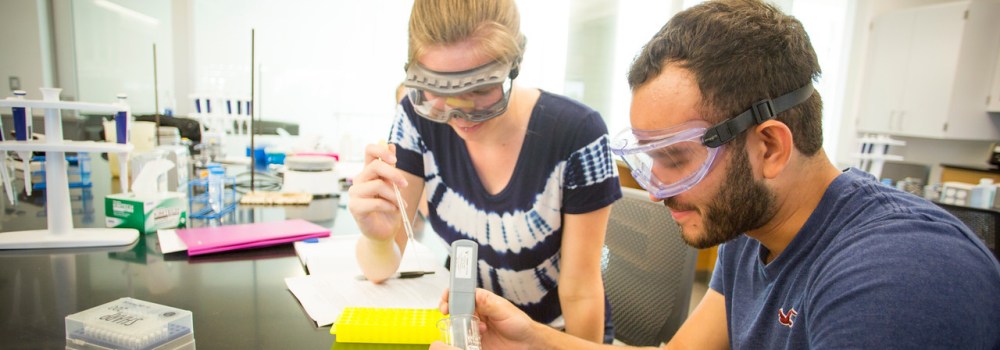
The Chemistry & Biochemistry Department is located in the Featherston Life Sciences Building. The Department has an extensive selection of modern instrumentation that is utilized in both undergraduate teaching labs as well as undergraduate research projects. Chemistry and Biochemistry majors benefit from small class and laboratory size, day to day personal contact with faculty and staff, and hands-on operation of chemical instrumentation.
-
Nicole Bouvier-Brown
Environmental chemistry; air quality; Atmospheric chemistry; Volatile organic compounds (VOCs); Biogenic VOCs; Environmental Justice
S.W. Tina Choe
Development of new synthetic methods in organic chemistry, pedagogical research to improve science education
Lambert Doezema
Measurement of C2 to C10 hydrocarbons using Gas Chromatography; various environmental projects including: monitoring Los Angeles hydrocarbon levels and quantifying hydrocarbon sources, wetlands air quality monitoring and monitoring emissions from oil drilling operations
Stephen Heller
The Heller Research Group is broadly engaged in the synthesis of organic molecules, focusing on the development of novel chemoselective acylations, new methods for the synthesis of complex nitrogen-containing rings, and the synthesis of bioactive alkaloids
Ryan Hunt
The Hunt lab explores the excited state dynamics of small molecules using spectroscopy and quantum chemistry. Topics of current exploration include: photobases/photoacids, molecules that become more basic/acidic when exposed to light; and organic photocatalysts, which convert the energy from light into a drive for electron transfer that can be used in interesting synthetic reactions.
Emily Jarvis
The Jarvis lab uses computational chemistry to explore structure and reactivity of molecular and solid materials. The overarching objective in these studies is to contribute to alternative energy improvements by improving photocatalyst design and tuning electronic properties of molecules and solids for optimum performance guided by the principles of green chemistry.
Jeremy McCallum
Studying oxidation mechanisms of biomolecules, specifically the oxidation of guanine derivatives and oxidants produced from the irradiation of antibodies
David Moffet
My students and I are investigating the role of misfolded proteins in disease. We specifically focus on the role of Islet Amyloid Polypeptide (IAPP) in the progression of type 2 diabetes.
Kathryn Mouzakis
The Mouzakis Lab uses biochemical and molecular tools to study viruses that infect and cause human disease. The virus life cycle describes all of the steps needed to make more virus. Our research focuses on a specific step in this life cycle that is common to viruses with RNA genomes and is critical to their replication. The majority of questions we are trying to answer are aimed at understanding how this step happens at a molecular level. A subset of our research is directed at disrupting this step as a means of antiviral therapy. You can learn more about our ongoing research efforts at mouzakislab.lmu.build.
Thomas Reilly
p-Block clusters, especially boranes and carboranes; inorganic reagents in organic synthesis and asymmetric synthesis
-
At LMU, undergraduates in Chemistry and Biochemistry are able to take advantage of the Department's exceptional array of modern chemical instrumentation.
The following is a list of the department's major equipment holdings:
- Amersham AKTA prime Automated Liquid Chromatography System
- Asylum Research MFP-3D SA AFM/ARC2 – Atomic Force Microscope (college shared)
- Beckman DU-70 UV/VIS Spectrophotometer
- Beckman Model J2-21 Refrigerated Centrifuge
- Beckman Progammable Solvent Module 126 and Diode Array Detector Module 168 System 32 Karat HPLC
- BioRad MyCycler Thermocycler
- Bruker AVIII400 Nanobay - Nuclear Magnetic Resonance (NMR) Spectrometer with Automation (BACS-60 sample changer) (college shared)
- Bruker GC-436, MS-Triple Quadrupole - Gas Chromatograph- Mass Spectrometer (GC-MS)
- Bruker Scion GC-436 – Gas Chromatograph
- Bruker Alpha FT-IR Spectrometer (2X)
- Bruker Tensor II FT-IR Spectrometer
- Bruker 450-GC, 430-GC – Gas Chromatograph
- Dionex IC25 Ion-Exchange Chromatograph
- Dynex Opsys MR Microplate Photometer
- EG&G model 263 Potentiostat/Galvanostat with model 303A GMDE Potentiometer
- FEI SEM QUANTA 200 – Scanning Electron Microscope (college shared)
- GOW-MAC Series 400 Gas Chromatograph (2X)
- Hitachi F-2000 Fluorescence Spectrometer with Stirrer
- Jasco J-850-150S - Circular Dichroism (CD) Spectrometer
- Labconco FreeZone Plus 12
- Mattson Polaris FTIR
- Microcal Differential Scanning Calorimeter
- Perkin Elmer 1600 series FTIR Spectrometer
- Perkin Elmer Spectrum RX 1 FTIR (2)
- Perkin Elmer 1760 series FTIR with Spectra-Tech IR Microscope
- Perkin Elmer DNA Thermal Cycler
- Perkin Elmer ELAN DRC-e. - Inductively Coupled Plasma-Mass Spectroscopy (ICP-MS) (college shared)
- Perkin Elmer Flexar FX-15 UHPLC, Flexar FX-PDA UHPLC detector, Flexar SQ300 MS - Liquid Chromatograph Mass Spectrometer (LC-MS)
- Perkin Elmer Gas Chromatograph, model 8500
- Perkin Elmer AAnalyst 200 Atomic Absorption Spectrometer
- Perkin Elmer Lambda 20 UV/VIS Spectrophotometer
- Perkin Elmer Lambda 25 UV/VIS Spectrophotometer (2X)
- Perkin Elmer Lambda 35 UV/VIS Spectrophotometer
- Perkin Elmer Lambda 40 UV/VIS Spectrophotometer
- Perkin Elmer Zeeman 4100ZL Graphite Furnace Atomic Absorption Spectrometer
- Shimadzu AA-6300 (GFA-EX7i, ASC-6100) - Graphite Furnace Atomic Adsorption Spectrometer (GC-AAS)
- Sievers 800 Portable Organic Carbon Analyzer (TOC Analyzer)
- Varian 3400 Saturn II Gas Chromatograph-Mass Spectrometer (GC-MS) (college shared)
- Varian Gas Chromatograph, Model 3800 with Electron Capture Detector and FID (2) Detectors
- Varian Gas Chromatograph, Model 3400 with Flame Ionization Detectors
- Varian Gas Chromatograph, Model 3600 with FID Detectors (2x)
- Varian ProStar (HPLC)
- Zeiss Confocal LSM 5 Exciter Vario Two RGB with Zen 2008 – Confocal Microscope (shared for college)